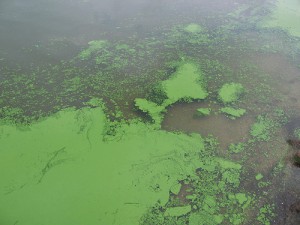Fertilizer runoff leads to larger Chesapeake Bay dead zone
 Photo credit: Dr. Jennifer L. Graham - U.S. Geological Survey
Photo credit: Dr. Jennifer L. Graham - U.S. Geological Survey
Last week, The Washington Post reported that the Chesapeake Bay’s ‘dead zone’—a portion of the bay completely devoid of oxygen—is back and bigger than normal, encompassing an area of one cubic mile. Dead zones occur when fertilizer runoff high in nitrogen and phosphorus enters the water and leads to the over-growth of algae. Algal over-growths eventually die and decompose, depleting oxygen in the water and leaving an anoxic area where no aquatic organism can survive. Slower moving animals, such as crabs, often cannot escape quickly enough, resulting in animal die offs. One of the major causes of dead zones, particularly in the Chesapeake Bay, is heavy fertilizer runoff from farms directly into the Bay and its tributaries.



